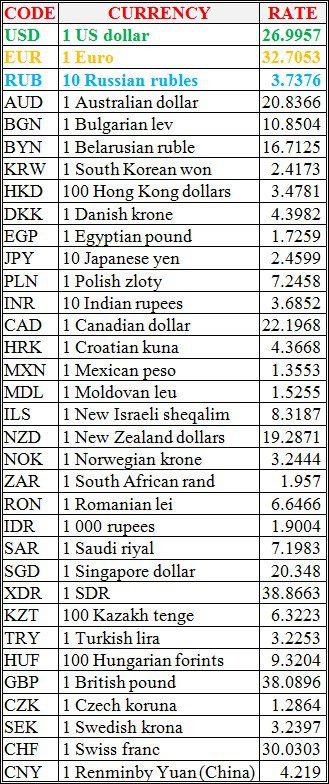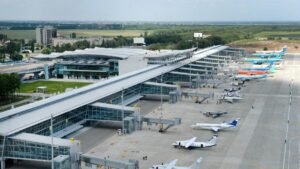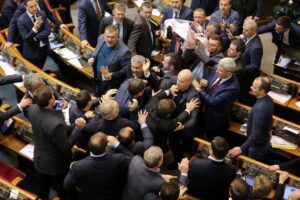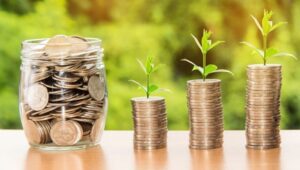National bank of Ukraine’s official rates as of 15/06/21

Source: National Bank of Ukraine

Passenger traffic at Boryspil airport (Kyiv) has tripled compared to the beginning of spring, about 30,000 passengers are checked in per day, the chief of staff of the Kyiv separate checkpoint, Lieutenant Colonel Pavlo Matviychuk, has said.
“Let’s start with the passenger traffic flow, which in March … was about 10,000 people and 1,000 vehicles per day. Now we carry out registration at Boryspil airport – this is about 30,000 passengers per day. That is, passenger traffic increased significantly in summer,” Matviychuk said at a briefing at Boryspil airport.

CC Continental City Capital LTD (Cyprus) has announced the acquisition of 40% and 19.08% of the shares of Point insurer (Kyiv), according to information base of the National Securities and Stock Market Commission of Ukraine.
It is also noted that the contract for the purchase and sale of securities with Joint Century Ltd. (Belize) according to which CC Continental City Capital LTD becomes the owner of 392 voting shares or 40% of the charter capital of the insurer was concluded on June 14. On the same day, a sale and purchase agreement was signed with citizen of Georgia Armazi Tavadze on the acquisition of 187 voting shares or 19.08% of Point.
As reported, on April 30, 2021, the National Bank of Ukraine allowed Rati Tchelidze to acquire a significant stake in Point insurer by indirectly owning 56.02% of the shares.
As reported, the supervisory board of the insurance company on April 9, 2021 terminated the powers of chairman of the board Levan Bezhashvili and appointed Daria Havrylytsia to this position.
PJSC Point insurer is the legal successor of CJSC Soborny Capital insurer. It has been working in the insurance market since 2003. The company specializes in risk insurance.

President of Ukraine Volodymyr Zelensky said if the Verkhovna Rada does not adopt the law on de-oligarchization, there is no point in dissolving parliament.
“I think that today Ukraine needs stability, that is why there are laws on de-oligarchization and on a referendum, when you can calmly resolve issues. Therefore, there is a law on lifting immunity and a law on impeachment. Everything should be regulated at the legislative level […] there is no point in dissolving the Verkhovna Rada today from the point of view of stability,” Zelensky said during a conversation with journalists at the Ukraine 30. Economy without Oligarchs all-Ukrainian forum.
According to the head of state, he is “confident in the Servant of the People party, which should support the bill.”
“There are also several democratic parties, as they call themselves. I think they should also support this initiative, despite the fact that it was my initiative, not theirs. Although in the future they will say that it was a joint initiative. The main thing now is to go through this process. This is a civilized way out from under the influence of oligarchs – for the government, business, individual officials and for oligarchs,” he said.
At the same time, as Zelensky sad the following: “If it happens that parliamentarians want to turn from legislators into businessmen, the president will expect support in society.”
“Then I will have a plan B,” he said.

The Dutch company Bontrup plans at the first stage to invest EUR 50 million in energy projects in the Chornobyl exclusion zone as part of the implementation of the concept of Ukraine’s “green” energy transition, the Economy Ministry reported.
According to the report, Bontrup representatives discussed this proposal during a meeting with First Deputy Prime Minister-Minister of Economy Oleksiy Liubchenko, Deputy Minister Iryna Novikova, as well as with Acting Head of the State Agency on Energy Efficiency and Energy Saving Kostiantyn Hura and Head of the State Agency on Exclusion Zone Management Serhiy Kostiuk.
“The parties discussed the proposal of the Bontrup representatives on the implementation of an investment energy project on the territory of the Chornobyl exclusion zone as part of the implementation of the concept of a “green” energy transition in Ukraine,” the ministry said.
Bontrup also estimates the prospect of increasing the volume of investments at EUR 1.5 billion. According to the initiators, the implementation of the project will provide jobs for about 10,000 households, the ministry said.